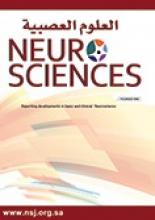Abstract
OBJECTIVE: To find out incidence of seizure recurrence and its risk factor after the first unprovoked attack in children below 12 years of age.
METHODS: A prospective study was carried out between 30th April 1996 - 1st May 1997 with the aim to find out the incidence of seizure recurrence and its risk factor after the first unprovoked attack in children below 12 years of age. All patients aged between 2 months - 12 years who presented with first unprovoked seizure at Hamad General Hospital, Doha, Qatar were studied. Seizures due to fever, metabolic causes, post-traumatic,and myoclonic seizures, infantile spasms, absence epilepsy and pseudo-seizures were excluded. All patients were followed for a minimum of one year. Possible risk factors such as sex, age, family history of epilepsy, delayed development, focal onset, clustered onset (two or more attacks within 24 hours), abnormal neurological findings and epileptogenic activity of electroencephalography were considered.
RESULTS: There was a total of 33 patients (14 male and 19 female), 11 patients (33%) had recurrence. Significant risk factors for seizure recurrence were abnormal encephalograms (p=0.009), positive family history (p=0.03) and cluster onset (p=0.04). Presence of one or more risk factor (p=0.01) was significant. The other risk factors were not statistically significant.
CONCLUSION: The incidence of seizure recurrence is higher in-patients who have one or more risk factors. The patient and the family should be aware about possibility seizure recurrence and should be involved in the decision of starting treatment after first attack.
- Copyright: © Neurosciences
Neurosciences is an Open Access journal and articles published are distributed under the terms of the Creative Commons Attribution-NonCommercial License (CC BY-NC). Readers may copy, distribute, and display the work for non-commercial purposes with the proper citation of the original work.






